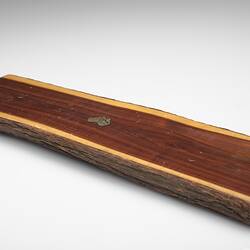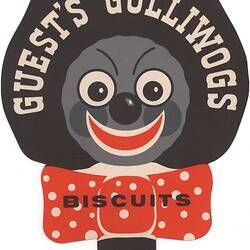Summary
Note: This object includes a derogatory slur, depiction of and reference to First Nations people. Such words and sentiments are not condoned by Museums Victoria which considers them to be racist. Historical distance and context do not excuse or erase this fact.
Rectangular shaped piece of mulga wood with bark left in place on the two long sides, 1930s. On the front side are 124 holes used for scoring in the card game of cribbage.
The Mulga wood 'Abo' brand was patented by Albert J. Wiley of Adelaide in 1932. A.J. Wiley had owned a woodturning business in Adelaide at least since 1902. By the 1930s Wiley had become a specialist in mulga wood ornaments. Wiley inspired Fred Eaton, camp missionary at Nepabunna to install lathes at the mission in order to teach the Aboriginal people under his care woodturning in 1938.
Physical Description
Almost rectangular shaped piece of mulga wood with bark left in place on the two long sides. On the front side are 124 holes used for scoring in the card game of cribbage. On the reverse is stamped in gold the maker's mark of a map of Australia (missing Tasmania( and the face of a First Peoples man. The right hand edge of the board has a metal plate screwed into it, possibly as a latter addition to hold together a split in the wood.
Significance
Mulga wood, an Australian acacia, was used by First Peoples to make boomerangs, spear points and shields. In the early twentieth century the wood became a popular timber for ornaments and souvenirs, such as this cribbage board. The way this particular piece was branded demonstrates the exploitation of First Peoples and First Peoples' culture to market products while attempting to legitimise a common racial slur.
As recently as the 2000s, such terms and imagery have been used, such as Tourism NT, a Northern Territory government agency, who paid for a sponsored Google link to this slur on the internet until it was removed on May 12, 2010.
More Information
-
Collecting Areas
-
Acquisition Information
Purchase
-
Maker
Mr Albert J Wiley, Adelaide, Greater Adelaide, South Australia, Australia, 1930s
-
Inscriptions
Reverse: maker's mark: Mulga wood Abo brand
-
Classification
-
Category
-
Discipline
-
Type of item
-
Overall Dimensions
290 mm (Width), 80 mm (Depth), 23 mm (Height)
-
References
[Link 1] [Link 2] South Australia, Report of the Chief Protector of Aborigines for the year ended 30th June, 1938, p.2 [Link 3] [Link 4]
-
Keywords
Aboriginal Depictions, Gaming Activities, Racism, Woodturning Industry, Cultural Stereotypes





